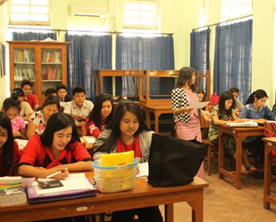Development potential is strengthening in different sectors for the rapid-changing Myanmar. But management of widespread capacity challenges comes out as the main concern in actualising this prospect since the nation just being emancipated from a protracted international isolation is left with terrible human capital needs that result in setbacks for deployment of the refreshing opportunities prompted by the newfound political turnaround. Although the country now boasts the fastest growth rate prediction regionally, the staggering capacity challenges in hand provoke conjectures that the NLD-led government’s advance towards the much-anticipated prosperous future is likely to be held back by human resource-related troubles.
Labour-intensive Industries in Priority
As found in certain emerging economies around the world, Myanmar has designed a set of industries into a prioritised development framework for having high potential to play a vital role in pursuit of national development. The seven sectors identified as a major collective driving force for development are agriculture, energy and mining, tourism, financial sector, infrastructure, manufacturing and telecommunications. Almost all of those sectors are labour-intensive industries that can generate millions of jobs in the country’s labour market. For example, tourism industry with strong prospect of generating a large number of employments over the coming years has been forecast to create more than one million jobs by 2020 as stated in a briefing paper delivered by Luxembourg Agency for Development Cooperation (LuxDev), the aid and development agency of the government of Luxembourg. The briefing paper draws on findings from industry research strands conducted to prepare a Human Resource Development Strategy and Action Plan for the sector. It is a worthwhile designation for Myanmar to position the labour-intensive industries as the main drivers for economic growth since the nation of 52 million possesses a large working age population (those aged 15-64) according to the data from the 2014 Myanmar census. And an estimated 3 to 5 million migrant workers is expected to have a substantial contribution to development of the homeland through their foreign-acquired experience upon their return.
Vocational Training for Labour Market Needs
Despite the favourable linkage between a large working age population and the framing of labour-intensive industries as the progress drivers, Myanmar finds it uneasy to exploit this harmony by reason of the lack of development in human resources. The desperate human capacity needs hinder the country to cope with the increased skill demands of rising job opportunities induced by the growing industries. Thus, the country should go for a better promotion of vocational training in an attempt to fulfill the growing skill necessities of a demanding labour market.
The current context requires Myanmar to pay more attention/special consideration to vocational training as a tool to develop its human resources in light of the capacity needs for driving the economy, ensuring a systematised approach to the activity. The country has already seen a total of 13 ministries including the Ministry of Education conducting TVET (Technical and Vocational Education and Training) courses at 247 training schools. And more than 210 courses on 16 types of TVET are being opened by the private sector according to the official data. The Centre for Vocational Training (CVT) located in Botataung Township in Yangon and the Singapore-Myanmar Vocational Training Institute (SMVTI) situated in Bahan Township also in Yangon are two well-known vocational training providers established by foreign assistance, CVT Myanmar being Swiss-backed and SMVTI being a Singaporean contribution to Myanmar’s human resource development.
Yet, Myanmar needs to expand the current vocational training environment and intensify the system if it wants to successfully overcome the scarcity of skilled labour in industries and avoid the future economic woes that may result from the implications of longterm labour shortage and the recruitment of un-professionalized or unprepared staff in the workforce. The government is responsible to undertake a more focused and comprehensive management of vocational training by reviewing and leveraging the existing resources. A wide range of activities aimed at the improvement of local vocational training community should be initiated by the government – such as building connections between training providers and exchange of teaching methods and educational ideas, developing strategies that outreach the youth to access to training, strengthening relations between training institutions and the labour market (academia-industry linkages), encouraging the training institutions through the supportive measures of local authorities, making concerted efforts to standardise the training curricula and setting up evaluation mechanisms to examine the impact of training.
A 2015 factsheet issued by Swiss Agency for Development and Cooperation (SDC), a partner of CVT Myanmar which has assisted Myanmar in development projects by focusing on vocational training, revealed identified challenges from the in-depth TVET system analysis that can be summarised as follows: a) high unemployment especially among the youth, b) limited access to skills development, c) high drop-out rates from schools and training providers, d) unmet skill needs in industries and the mis-alignment with labour market needs, and e) the insufficient quality and relevance of training curricula.
Government Eyes Vocational Training for Development
The State Counsellor Aung San Suu Kyi called for the promotion of vocational education in Myanmar when addressing the Technical Vocational Education Training Forum held in Naypyidaw in July. She called on the students and parents to value the vocational education, saying that the Myanmar society normally appreciates university education rather than vocational education. Vocational education is regarded as second-class in Myanmar, the State Counsellor said.
She emphasised that the role of vocational education is expanding worldwide. Only when vocational education is developed in the country, there will be better livelihoods and living standards for the people, added Aung San Suu Kyi. Pointing out the countries that have managed to achieve development by focusing on vocational training, the State Counsellor stressed to make great efforts in transforming Myanmar into a developed economy by employing the existing opportunities.
Myanmar government’s 12-points economic policy document released in July also featured the emphasis on human resource development and vocational training, looking to prioritise the labour-intensive industries. Minister for Planning and Finance Kyaw Win said the government collects kyats 7.8 billion a month from the ‘top-up’ tax on mobile phones and they will utilise this earnings in vocational training for human resource development.
The government’s move to more concentrate on vocational training can also be presumed as a recognised response to observer suggestions made by international financial and development organisations such as the World Bank and the Asian Development Bank which have warned that capacity building is one of the biggest challenges on the way to development for Myanmar.
The Gravity of Human Capital Development
Development in human capital is essential for rapid and sustainable economic growth in Myanmar, a 2015 ADB economics working paper said. The pace of growth in the Myanmar economy is determined in part by the quality of its labour force. To enhance the quality of the workforce, an optimum answer for Myanmar is to select a better focused approach to vocational training.










